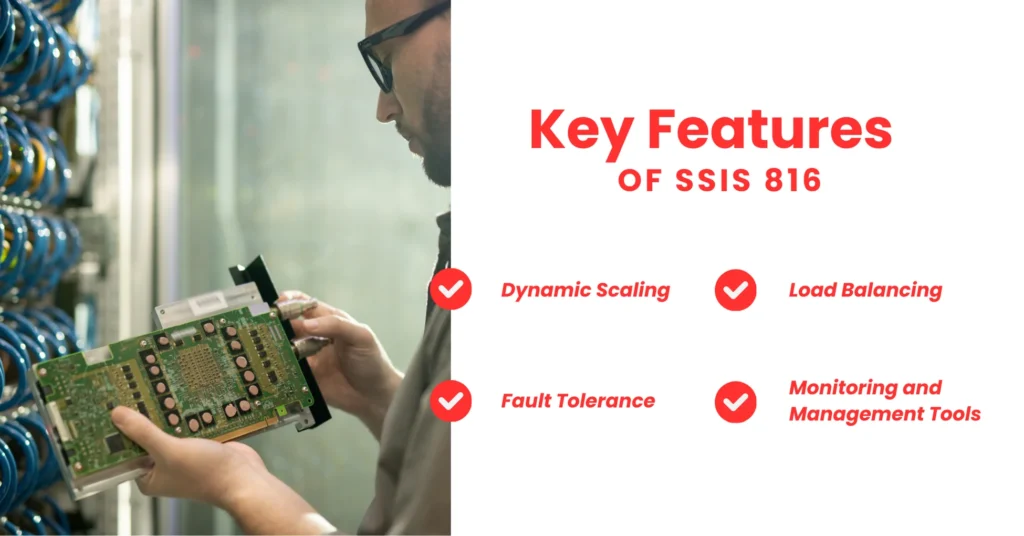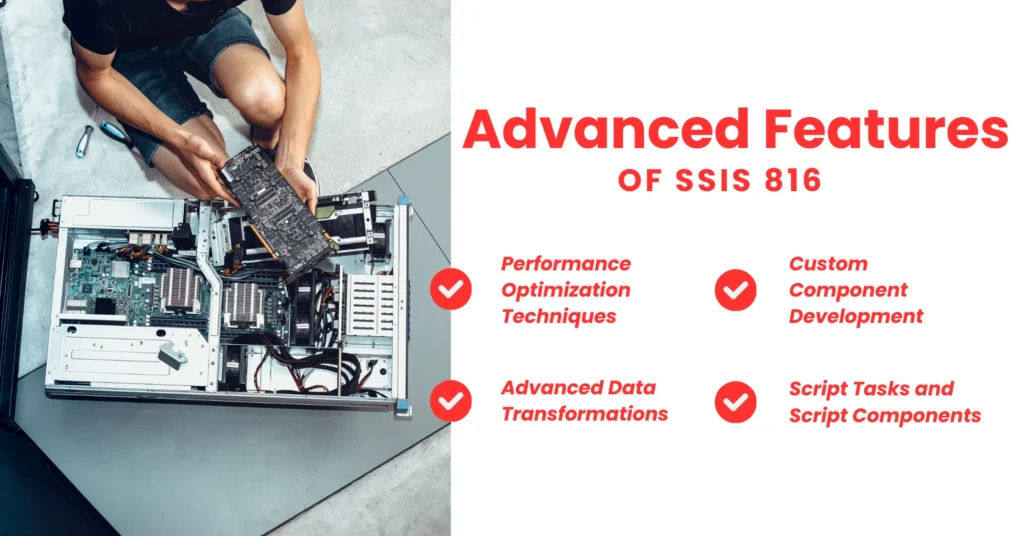The Comprehensive SSIS 816 Handbook: Mastering Integration with Expert Tips and Tricks
In the realm of data integration and ETL (Extract, Transform, Load) processes, SQL Server Integration Services (SSIS) 816 stands out as a powerful tool for data professionals. Whether you’re new to SSIS or looking to upgrade your skills, this guide will provide a comprehensive overview of SSIS 816, covering its features, benefits, and practical applications.
Introduction to SSIS 816
What is SSIS 816?
SSIS 816, short for SQL Server Integration Services version 816, is a robust platform developed by Microsoft for data integration and workflow automation. It enables organizations to design, deploy, and manage data integration solutions effectively, catering to diverse industry needs. SSIS helps businesses streamline data from various sources, transform it into useful formats, and load it into destinations for analysis and reporting. This capability makes SSIS 816 a vital tool for managing large-scale data projects efficiently.

Brief History and Evolution of SSIS 816
“SSIS has evolved significantly since its inception. Initially part of SQL Server 2005, SSIS replaced the older Data Transformation Services (DTS). Each subsequent version has brought significant improvements in terms of performance, scalability, and features. SSIS 816, being one of the latest iterations, incorporates advanced functionalities that address modern data integration challenges. The continuous evolution reflects Microsoft’s commitment to keeping SSIS aligned with current technological advancements and user needs.
Importance and Applications of SSIS 816
SSIS 816 is essential in modern data management for several reasons. It helps organizations maintain data consistency, improve data quality, and reduce manual efforts in data handling. Common applications of SSIS include data warehousing, where it integrates data from various sources into a centralized repository; business intelligence, where it prepares data for analysis and reporting; and large-scale data migrations. These applications ensure that decision-makers have access to reliable data, which is critical for strategic planning and operations.
Key Features of SSIS 816
Overview of Core Features
SSIS 816 comes with a suite of powerful features designed to simplify complex data integration tasks. These include advanced data transformation capabilities, a rich set of data connectors, and robust workflow automation tools. It also offers extensive error handling and logging mechanisms to ensure data processes run smoothly and any issues are promptly addressed.

Dynamic Scaling
Dynamic scaling in SSIS 816 allows the platform to automatically adjust resources based on workload demands. This means that during high data processing times, SSIS can allocate more resources to ensure tasks are completed efficiently. This feature helps in maintaining consistent performance without manual intervention, making it ideal for organizations with fluctuating data volumes.
Load Balancing
The built-in load balancing feature of SSIS 816 distributes data processing tasks across multiple servers. This not only improves efficiency but also reduces the time required to complete data integration processes. By balancing the load, SSIS ensures that no single server is overwhelmed, leading to faster and more reliable data handling.
Fault Tolerance
Enhanced fault tolerance in SSIS 816 ensures that ETL processes continue seamlessly even if a server fails. This reliability is achieved through automatic rerouting of tasks and error recovery mechanisms. Fault tolerance is crucial for mission-critical applications where data processing cannot afford interruptions.
Monitoring and Management Tools
SSIS 816 includes comprehensive monitoring and management tools that provide real-time insights into the performance and health of your data integration solutions. These tools allow administrators to track the progress of ETL tasks, identify bottlenecks, and take corrective actions as needed. This level of oversight ensures that data processes remain efficient and any issues are quickly resolved.
Advantages of Learning SSIS 816
Career Opportunities and Industry Demand
Mastering SSIS 816 can open up numerous career opportunities in the fields of data management, business intelligence, and analytics. As businesses rely more on data-driven decision-making, the need for proficient SSIS professionals is on the rise. These roles often come with competitive salaries and the chance to work on cutting-edge data projects.
Benefits for Data Professionals
For data professionals, SSIS 816 provides the tools needed to handle complex data integration tasks efficiently. It enhances their ability to manage large datasets, automate repetitive tasks, and ensure data quality. Proficiency in SSIS 816 can significantly improve a professional’s ability to contribute to data-centric projects and solutions within their organization.
Enhancing Data Integration Skills
Learning SSIS 816 not only improves your data integration skills but also equips you with a deeper understanding of ETL processes. This knowledge is essential for designing, deploying, and managing sophisticated data integration solutions. With SSIS 816, you can tackle more complex data challenges and deliver more efficient and reliable data solutions.
Read Also: 127.0.0.1:62893: A Comprehensive Guide To Fixing Error
Getting Started with SSIS 816
System Requirements and Installation
To get started with SSIS 816, ensure your system meets the necessary requirements. These typically include a compatible version of SQL Server, sufficient memory, and storage capacity. The installation process involves following guided steps provided by Microsoft, which include setting up the SSIS components within your SQL Server environment. Detailed documentation and support resources are available to assist with the installation.
Initial Setup and Configuration
Upon installation, configuring SSIS 816 entails establishing connections to data sources, defining package parameters, and setting up execution options. This setup is crucial as it determines how SSIS will interact with your data environment. Proper configuration ensures efficient data handling and seamless integration with other systems.
Basic Concepts and Terminologies
Familiarizing yourself with essential SSIS concepts such as control flow, data flow, connection managers, and event handlers is key to using SSIS effectively. Control flow defines the sequence of tasks, data flow handles the movement and transformation of data, connection managers manage links to data sources, and event handlers respond to events during package execution. Understanding these basics will help you navigate and utilize SSIS 816 more efficiently.
Components of SSIS 816
Data Flow Components
Data flow components are the core of SSIS 816, responsible for extracting, transforming, and loading data. They facilitate the movement of data from sources to destinations while applying necessary transformations. Components like data sources, transformations, and data destinations work together to ensure data is processed and loaded accurately.
Control Flow Components
Control flow components manage the execution of tasks within an SSIS package. They allow you to define the logical sequence of operations, including tasks such as data extraction, file operations, and executing SQL commands. Control flow components ensure that tasks are executed in the correct order, enabling complex workflows to be automated.
Connection Managers
Connection managers in SSIS 816 are used to establish connections to various data sources. They store the connection information required to access data from databases, flat files, cloud services, and other sources. Connection managers make it easy to reuse connections across different tasks and packages, ensuring consistency and efficiency in data handling.
Event Handlers
Event handlers provide a mechanism to respond to specific events during the execution of an SSIS package. They allow you to define actions that should occur when certain events, such as errors or warnings, are triggered. This feature helps in proactive monitoring and troubleshooting, ensuring that any issues are addressed promptly.
Variables and Parameters
Variables and parameters offer flexibility and control over SSIS packages. Variables store values that can change during package execution, allowing for dynamic data handling. Parameters enable customization of packages, making it possible to pass different values for execution, thus enhancing reusability and adaptability.
SSIS 816 for Data Integration
Connecting to Various Data Sources
SSIS 816 provides extensive connectivity options, enabling integration with a wide range of data sources. Whether it’s relational databases like SQL Server and Oracle, flat files such as CSVs, or cloud services like Azure, SSIS can connect and pull data from multiple origins. This versatility makes SSIS an ideal tool for comprehensive data integration needs.
Data Transformation Techniques
Transforming data is a critical aspect of ETL processes. SSIS 816 offers a broad array of data transformation techniques, including data cleansing, aggregation, sorting, and lookups. These techniques allow you to modify data into the desired format before loading it into the target system, ensuring data is accurate and meets business requirements.
Data Cleansing and Quality Control
Ensuring data quality is paramount in any data integration process. SSIS 816 includes tools for data cleansing and quality control, such as removing duplicates, standardizing data formats, and validating data against defined rules. These features help maintain high data quality, which is essential for reliable analysis and reporting.
ETL Process Implementation
Implementing ETL processes with SSIS 816 involves designing and executing packages that extract data from sources, apply necessary transformations, and load it into target destinations. The intuitive interface of SSIS 816 allows you to visually design ETL processes, making it easier to create, test, and deploy data integration solutions.
Advanced Features of SSIS 816

Performance Optimization Techniques
Optimizing the performance of your SSIS packages is crucial for handling large datasets and complex transformations. Best practices include minimizing the use of blocking transformations, optimizing memory usage, and parallelizing data flows. SSIS 816 provides tools and settings that help you fine-tune package performance for maximum efficiency.
Custom Component Development
SSIS 816 allows for custom component development using .NET languages like C#. This capability lets you extend the functionality of SSIS by creating custom tasks, transformations, and data sources tailored to your specific needs. Custom components can address unique business requirements that are not covered by built-in SSIS features.
Advanced Data Transformations
Advanced data transformations in SSIS 816 enable you to handle complex data scenarios. Examples include pivoting and unpivoting data, implementing fuzzy lookups, and using advanced expression language for data manipulation. These transformations provide greater flexibility and power in processing and integrating diverse data types.
Script Tasks and Script Components
Script tasks and script components allow you to use custom code within your SSIS packages. This feature is useful for implementing specific business logic, error handling, and complex data transformations that are not possible with out-of-the-box SSIS components. Using scripting languages like C# or VB.NET, you can write scripts to customize the behavior of your SSIS packages, making them more adaptable to your specific data integration needs. This level of customization is particularly valuable in scenarios where standard components fall short.
Best Practices for Using SSIS 816
Designing Efficient Packages
When designing SSIS packages, it’s essential to focus on efficiency and maintainability. Use modular design principles by breaking down complex processes into smaller, manageable tasks. This approach not only makes packages easier to understand but also simplifies debugging and maintenance. Additionally, leverage SSIS features like templates and reusable components to streamline development and ensure consistency across packages.
Error Handling and Logging
Implementing robust error handling and logging mechanisms is crucial for managing SSIS packages. Configure event handlers to capture and respond to errors, and use logging to record detailed information about package execution. This setup helps in diagnosing issues quickly and ensures that data processes can be monitored effectively. Always test error handling paths thoroughly to ensure they work as expected under various scenarios.
Performance Tuning Tips
Optimizing the performance of your SSIS packages involves several strategies. Minimize the use of blocking transformations, which can slow down data flows, and consider parallel processing to improve throughput. Use data flow buffers efficiently by adjusting buffer size and row count settings. Regularly monitor package performance and make adjustments as needed to maintain optimal performance.
Maintaining Data Integrity
Ensuring data integrity throughout ETL processes is critical. Use SSIS components like the Checksum transformation to verify data consistency, and implement transactions where necessary to maintain data integrity during multi-step processes. Regularly validate data before and after transformations to ensure accuracy and completeness.
Scheduling and Automation
Automate the execution of SSIS packages using SQL Server Agent or other scheduling tools. This automation ensures that data integration tasks run at the desired times without manual intervention. Schedule packages during off-peak hours to minimize the impact on system performance and ensure timely data availability for reporting and analysis.
Troubleshooting and Debugging SSIS 816
Common Issues and Solutions
Despite careful design and implementation, issues can arise during SSIS package execution. Common problems include connection failures, data conversion errors, and performance bottlenecks. Address connection issues by verifying connection strings and network accessibility. Handle data conversion errors by ensuring data types are compatible and using data conversion transformations as needed. To resolve performance issues, review package design and optimize data flows.
Debugging Techniques
Effective debugging techniques are essential for resolving issues in SSIS packages. Use breakpoints to pause package execution and inspect variable values and data flows. The Data Viewer tool allows you to examine data at different stages within a data flow, helping identify where errors or unexpected data transformations occur. Additionally, leverage SSIS logging to capture detailed execution information, which can be invaluable for troubleshooting.
Monitoring Tools
SSIS 816 offers various monitoring tools to help you keep track of package execution and performance. SQL Server Management Studio (SSMS) provides built-in features for monitoring and managing SSIS packages. Additionally, SSIS includes performance counters that can be monitored using Windows Performance Monitor. These tools provide insights into package execution times, resource usage, and potential bottlenecks, enabling proactive management of your data integration processes.
Case Studies and Real-World Applications
Successful SSIS Implementations
Many organizations have successfully implemented SSIS to streamline their data integration processes. For example, a financial services company used SSIS to consolidate data from multiple sources into a centralized data warehouse, improving reporting accuracy and decision-making speed. Another case involves a healthcare provider using SSIS to integrate patient data from various systems, enhancing data quality and operational efficiency.
Lessons Learned
These case studies highlight important lessons for SSIS implementation. Key takeaways include the importance of thorough planning and design, regular performance monitoring, and the need for robust error handling mechanisms. They also emphasize the value of training and documentation to ensure that team members can effectively use and maintain SSIS packages.
Practical Tips from Industry Experts
Industry experts recommend several practical tips for successful SSIS use. Prioritize data quality by incorporating cleansing and validation steps into your ETL processes. Regularly review and update your SSIS packages to accommodate changes in data sources and business requirements. Finally, leverage the SSIS community and resources, such as forums, blogs, and training materials, to stay updated on best practices and new features.
Conclusion and Future Trends
Summary of Key Points
SSIS 816 is a powerful and versatile tool for data integration, offering a wide range of features to handle complex ETL tasks. Its capabilities in dynamic scaling, load balancing, and fault tolerance make it ideal for managing large-scale data projects. By following best practices in design, error handling, and performance tuning, you can maximize the efficiency and reliability of your SSIS packages.
Future Trends in SSIS and Data Integration
The future of SSIS and data integration is likely to be shaped by advancements in cloud computing, big data, and artificial intelligence. As organizations increasingly move to the cloud, SSIS will continue to evolve to support hybrid and cloud-native data integration scenarios. Additionally, integrating AI and machine learning capabilities into SSIS can enhance data processing and predictive analytics, providing deeper insights and more automated decision-making.
Encouragement to Explore SSIS 816 Further
Whether you’re a data professional looking to enhance your skills or an organization aiming to streamline your data integration processes, SSIS 816 offers a robust platform to meet your needs. Dive deeper into its features, experiment with different components, and leverage the wealth of available resources to master this powerful tool. By investing in SSIS 816, you position yourself and your organization to effectively manage and leverage data for strategic advantage.






